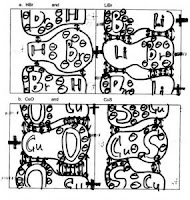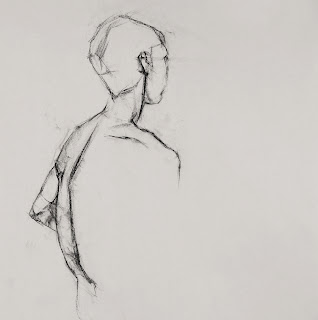life drawing 2
fall 2008
monday/wednesday
2:30 – 5:35 pm
applied arts 303
save all drawings done during the semester
pre•requisites
you must have completed life drawing 1 (art 3o1) before participating in life drawing 2.
course•objectives
in life drawing 2, you will:
- deepen your understanding of artistic anatomy.
- refine your use of line, mark-making, and value to describe the figure in illusionistic space.
- wrestle with complex drawing issues such as exaggeration and distortion of forms, description of the environment around the figure, development of multiple-figure compositions, etc.
- expand the use of media, scale, and point of view in your drawings.
- examine ways of representing the body.
- develop and research ideas, concerns, and obsessions you want to attend to in your drawings.
- look at historical and contemporary examples of other artists’ representations of the figure.
- find source material and imagery for creating your own drawings.
- use writing to explore influences, clarify ideas, and analyze drawings.
coursework
i expect you to
- attend class
- give considerable focus and energy to the drawing process, ask questions, engage in class discussions, communicate with me any concerns about the class or course work
- complete assigned course work:
in-class drawingsattendance
homework assignments
blog posts
final project
it’s important that you are in class—for access to the model, to hear comments i make, and to experience drawing in a studio setting. the class happens because all of you are here working together.
let me know via e-mail if you can’t make it to class.
rely on your classmates to show you drawings and notes you may have missed.
final exam
we will meet during the final exam time:
friday, december 19 from 2:00 - 3:50 p.m.
grading policy
• your grade will be based primarily on your final e-portfolio in which you showcase your learning over the semester and best examples from the class. this e-portfolio will include gesture drawings, long-pose drawings, maniken work, and blog summaries.
• a mid-term e-portfolio will be graded to give you an idea of your standing in the class at that point, but may be overridden by the quality of your final portfolio. In other words, the two grades will not be “averaged” for your final grade.
• your grade will also be affected by such “subjective” qualities as these:
1. are you present?
2. in mind as well as body?
3. open to suggestions?
4. helpful in class discussions?
5. awake during lecture time?
it is part of my job—my responsibility—to give you a grade that lets you and other art “authorities” (other professors, employers, grad schools, gallery owners, etc.) know how your final portfolio and overall attitude during class measure up to given standards.
one useful way to think about grades is to consider them guides as to how other art professionals (besides me) would view your portfolio. how would a design firm see your work? a graduate school acceptance committee? other professors in the art & design department? gallery owners?
if i imagine i am an employer of designers, an A would mean you could start right away, a B would mean you might get hired if you get some more experience and refine your portfolio, a C would mean you are not ready for the job.
likewise, if you are considering graduate school, an A would mean your work is of the quality that would get you accepted into a grad program, a B would indicate that you might get accepted if you worked on your portfolio some more, a C would mean you are not ready to apply for graduate studies (in drawing/life drawing, anyway).
materials
newsprint (18" x 24" or 24” x 36”)
large drawing paper (Strathmore 100 lb. rolls, 42” x 10 yds.)
other drawing paper and supports, depending on your needs
drawing board and clips
masking tape
ruler
charcoal
charcoal pencil
conte
conte pencil
erasers
ink with pen or brush
pastels
x-acto knife
sand paper
texts
atlas of human musculature in clay (volumes 1 – 5), jon zahourek, ed. kenneth morgareidge, zahourek systems, inc., 1994.
in addition to the texts, each student will be checked out a half maniken for his/her use during the semester. The manikens are property of uw-stout instructional resources services. you are responsible for the maniken checked out to you. if the maniken is missing, lost, damaged, etc., you are financially responsible to replace it through irs.
videos
world famous lectures on artistic anatomy & figure drawing
robert beverly hale
lecture 1 rib cage [78 minutes]
lecture 2 pelvis [ 81 minutes]
lecture 3 leg [74 minutes]
lecture 4 foot [ 72 minutes]
lecture 5 shoulder girdle I [77 minutes]
lecture 6 shoulder girdle ll [ 68 minutes]
lecture 7 arm [76 minutes]
lecture 8 hand [80 minutes]
lecture 9 head/skull [80 minutes]
lecture 10 head and features [97 minutes]
these are available in the library.
art education artifacts
the course objectives of this course meet:
• wisconsin standard 1: the teacher understands the central concepts, tools of inquiry, and structures of the discipline(s) he or she teaches.
• uw stout school of education domain 1a: demonstrating knowledge of content and pedagogy.
• wisconsin standard 9: the teacher is a reflective practitioner.
portfolio artifact: final project
• art education students will be required to reflect in writing on this artifact.
• art education students will be required to upload papers and digital images of their studio works into their e-portfolios.













